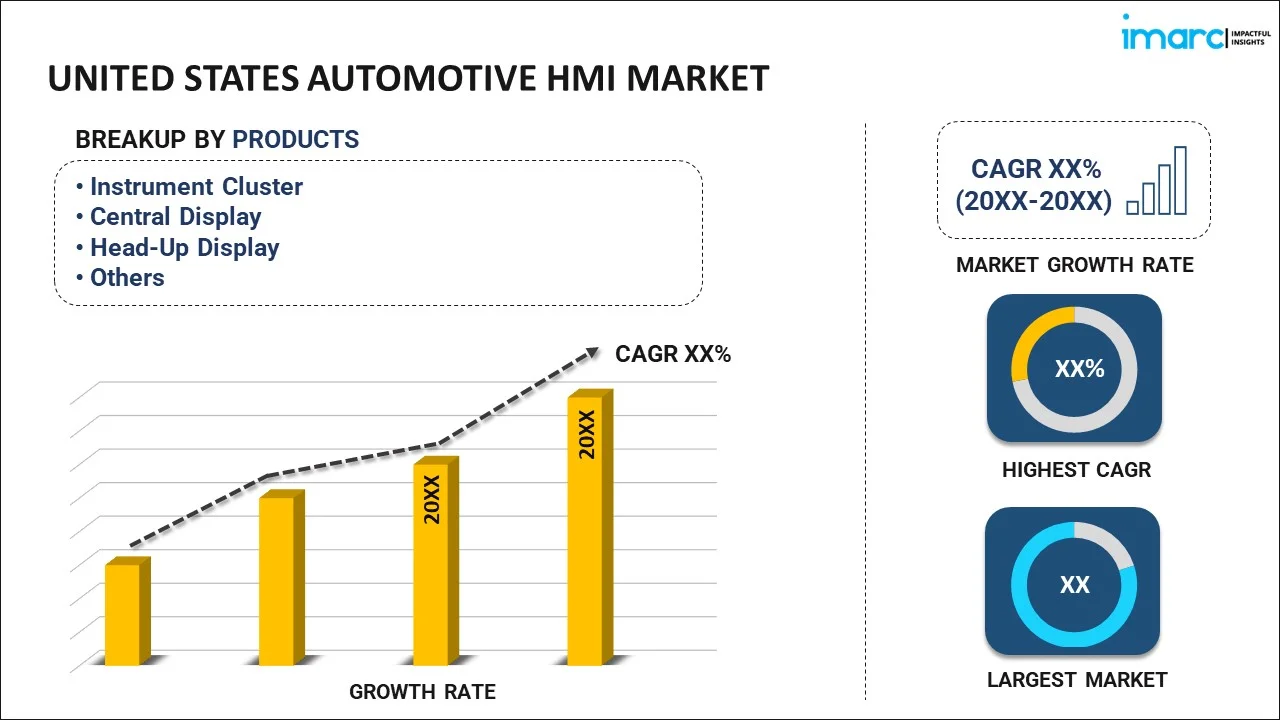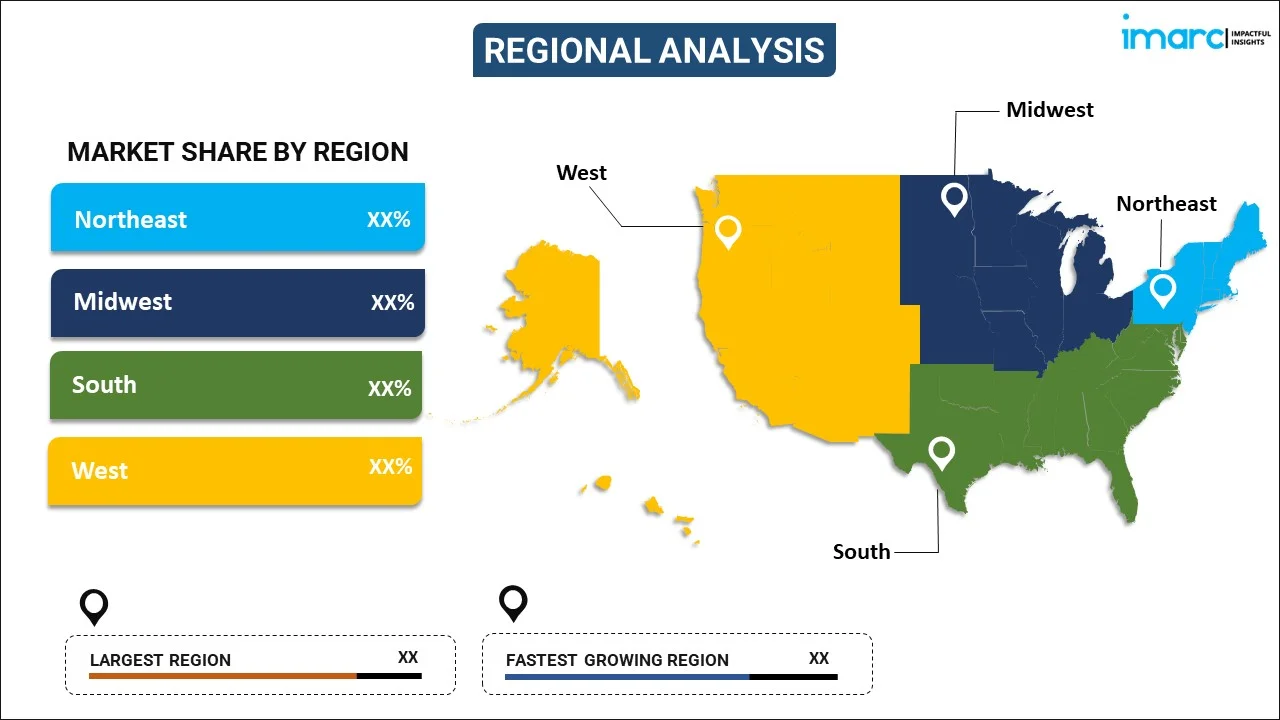
United States Automotive HMI Market Report by Product (Instrument Cluster, Central Display, Head-Up Display, and Others), Access Type (Standard, Multimodal), Technology (Visual Interface, Acoustic, Mechanical, and Others), Vehicle Type (Passenger Vehicles, Commercial Vehicles), and Region 2025-2033
Market Overview:
United States automotive HMI market size reached USD 5,800.1 Million in 2024. Looking forward, IMARC Group expects the market to reach USD 15,213.9 Million by 2033, exhibiting a growth rate (CAGR) of 11.31% during 2025-2033. The expanding automotive industry that is experiencing a trend towards increased connectivity, with more vehicles being equipped with advanced infotainment systems, connectivity features, and telematics is driving the market.
|
Report Attribute
|
Key Statistics
|
|---|---|
|
Base Year
|
2024 |
|
Forecast Years
|
2025-2033
|
|
Historical Years
|
2019-2024
|
| Market Size in 2024 | USD 5,800.1 Million |
| Market Forecast in 2033 | USD 15,213.9 Million |
| Market Growth Rate (2025-2033) | 11.31% |
United States Automotive HMI Market Analysis:
- Key Market Drivers: The US automotive HMI market is driven by increasing demand for advanced in-car experiences, increasing use of infotainment systems, and convergence of voice, gesture, and touch controls. These innovations improve safety, convenience, connectivity, and overall driver satisfaction in passenger as well as commercial vehicles.
- Key Market Trends: The market is shifting with AI-driven interfaces, augmented reality screens, and effortless smartphone connectivity. Customized and interactive driving experiences, digital cockpits, and advanced driver-assistance system compatibility are propelling innovation, satisfying customer demands, and defining the future of connected and semi-autonomous cars in the U.S. automotive market.
- Competitive Landscape: Top players in the United States automotive HMI market emphasize technology integration, strategic collaborations, and product innovation. OEM-tech company collaborations facilitate the creation of smart interfaces, enabling firms to differentiate products, increase market penetration, and solidify their competitive position in a rapidly growing and dynamic market.
- Challenges and Opportunities: Market challenges are high development expenditures, cybersecurity threats, and interface complexity, whereas opportunities are increasing adoption of autonomous vehicles, heightened demand for connected vehicles, and consumer interest in intuitive, energy-efficient, and eco-friendly in-car interfaces. These trends fuel investment and innovation in the U.S. automotive HMI market.
Automotive human-machine interface (HMI) refers to the technology that enables communication between a vehicle's systems and its human occupants. It encompasses the display screens, controls, and interactions that allow users to access and manage various features, such as navigation, entertainment, and vehicle settings. Advanced automotive HMIs employ touchscreen interfaces, voice recognition, gesture control, and augmented reality to enhance user experience and minimize driver distraction. The goal is to create intuitive and user-friendly interfaces that provide essential information while ensuring driver safety. As vehicles become more technologically sophisticated, HMI plays a crucial role in delivering a seamless and connected driving experience, promoting safer and more efficient interactions between drivers and their vehicles.
United States Automotive HMI Market Trends:
Integration of Advanced Infotainment and Connectivity Features
The United States automotive HMI market growth with the adoption of advanced infotainment and connectivity features. New vehicles are increasingly embedding multi-touch screens, voice command, gesture control, and personalized interfaces, which make it easier for drivers to control navigation, media, and communication systems while driving safely and in an efficient manner. These advanced systems enable smooth smartphone integration with music streaming, messaging, and connected app support while reducing driver distraction. Vehicle-to-vehicle (V2V) and vehicle-to-infrastructure (V2I) communication are also taking center stage in connected mobility, providing real-time traffic information, hazard warning, and predictive route suggestion. Personalization options in the form of driver profiles and adaptive display settings further improve ease of use, comfort, and enjoyment. These trends heavily influence the United States Automotive HMI Market size and overall penetration rates, in keeping with increasing consumer expectations. Together, these innovations form part of the, highlighting how trends in infotainment and connectivity are fueling market growth and defining the digital cockpits of the future in passenger and commercial vehicles.
Uptake of Artificial Intelligence and Augmented Reality Interfaces
Artificial intelligence (AI) and augmented reality (AR) technologies are revolutionizing the United States automotive HMI market trends by making intelligent, adaptive, and immersive car interfaces possible. AI-enabled HMIs can interpret driver behavior, forecast requirements, and offer customized advice for navigation, energy savings, and danger alerting. At the same time, AR heads-up displays superimpose critical data, such as speed, navigation commands, and traffic signals, over the windshield, minimizing distraction and enhancing situational awareness. AI-powered voice recognition systems enable natural language control for hands-free operation of entertainment, communications, and car functions. Gesture-based interactions and context-sensitive interfaces increase safety, convenience, and responsiveness even further, making the driving experience more intuitive. These technologies also enable advanced driver-assistance systems (ADAS) and semi-autonomous driving to deliver enhanced operational safety and efficiency. Widespread use of AI and AR in vehicle HMIs is one of the driving factors in the United States Automotive HMI Market analysis, indicating strong demand and technological momentum.
Digital Cockpits and Personalized User Experience
The market is shifting towards completely digital cockpits, which merge instrument clusters, infotainment systems, and climate controls into combined high-resolution displays. Digital interfaces allow drivers to personalize layouts, themes, and information shown based on individual tastes, making it easier and more engaging to use. Multi-modal interfaces, such as touchscreens, voice recognition, and gesture systems, permit unobstructed in-vehicle system management without distraction. Cloud connectivity and over-the-air updates to software mean that digital cockpits are up to date, responsive, and compatible with new features or applications. Latest display technologies, including curved OLED displays and interactive dashboards, improve vision, ergonomics, and appearance, providing a high-end user experience. Connected service integration, real-time traffic information, and preventive maintenance notices further enhance functionality and ease. Digital cockpit adoption constitutes the United States Automotive HMI Market size, with expanding interest in personalized experiences showcased in the market report creating ongoing growth throughout passenger and commercial vehicles.
United States Automotive HMI Market Segmentation:
IMARC Group provides an analysis of the key trends in each segment of the market, along with forecasts at the country level for 2025-2033. Our report has categorized the market based on product, access type, technology, and vehicle type.
Product Insights:

To get more information on this market, Request Sample
- Instrument Cluster
- Central Display
- Head-Up Display
- Others
The report has provided a detailed breakup and analysis of the market based on the product. This includes instrument cluster, central display, head-up display, and others.
Access Type Insights:
- Standard
- Multimodal
A detailed breakup and analysis of the market based on the access type have also been provided in the report. This includes standard and multimodal.
Technology Insights:
- Visual Interface
- Acoustic
- Mechanical
- Others
The report has provided a detailed breakup and analysis of the market based on the technology. This includes visual interface, acoustic, mechanical, and others.
Vehicle Type Insights:
- Passenger Vehicles
- Commercial Vehicles
A detailed breakup and analysis of the market based on the vehicle type have also been provided in the report. This includes passenger vehicles and commercial vehicles.
Regional Insights:

- Northeast
- Midwest
- South
- West
The report has also provided a comprehensive analysis of all the major regional markets, which include Northeast, Midwest, South, and West.
Competitive Landscape:
The market research report has also provided a comprehensive analysis of the competitive landscape. Competitive analysis such as market structure, key player positioning, top winning strategies, competitive dashboard, and company evaluation quadrant has been covered in the report. Also, detailed profiles of all major companies have been provided.
Latest News and Developments:
- In January 2025, BMW launched its all-new Panoramic iDrive system at CES 2025. The system, first seen in Neue Klasse models, includes panoramic dashboard display, optional 3D head-up display, central touchscreen, and multifunction steering wheel with haptic feedback, eliminating conventional physical buttons and increasing driver engagement and vehicle usability.
- In January 2024, Continental and Swarovski Mobility introduced the Crystal Centre Display. The 10-inch microLED display, set into precision-cut crystal, merges luxury and cutting-edge HMI technology, giving a floating-screen impression and transforming high-end vehicle interiors while winning the CES 2024 Innovation Award.
- In August 2024, Ford revealed that its 2025 Explorer will come with the new Android-based Digital Experience infotainment system, first seen earlier on the Lincoln Nautilus. The system features Google Maps, Google Assistant, wireless CarPlay, Android Auto, and digital HVAC controls, the first Ford vehicle to benefit from this advanced in-cabin technology.
United States Automotive HMI Market Report Coverage:
| Report Features | Details |
|---|---|
| Base Year of the Analysis | 2024 |
| Historical Period | 2019-2024 |
| Forecast Period | 2025-2033 |
| Units | Million USD |
| Scope of the Report | Exploration of Historical and Forecast Trends, Industry Catalysts and Challenges, Segment-Wise Historical and Predictive Market Assessment:
|
| Products Covered | Instrument Cluster, Central Display, Head-Up Display, Others |
| Access Types Covered | Standard, Multimodal |
| Technologies Covered | Visual Interface, Acoustic, Mechanical, Others |
| Vehicle Types Covered | Passenger Vehicles, Commercial Vehicles |
| Regions Covered | Northeast, Midwest, South, West |
| Customization Scope | 10% Free Customization |
| Post-Sale Analyst Support | 10-12 Weeks |
| Delivery Format | PDF and Excel through Email (We can also provide the editable version of the report in PPT/Word format on special request) |
Key Benefits for Stakeholders:
- IMARC’s industry report offers a comprehensive quantitative analysis of various market segments, historical and current market trends, market forecasts, and dynamics of the United States automotive HMI market from 2019-2033.
- The research report provides the latest information on the market drivers, challenges, and opportunities in the United States automotive HMI market.
- Porter's five forces analysis assist stakeholders in assessing the impact of new entrants, competitive rivalry, supplier power, buyer power, and the threat of substitution. It helps stakeholders to analyze the level of competition within the United States automotive HMI industry and its attractiveness.
- Competitive landscape allows stakeholders to understand their competitive environment and provides an insight into the current positions of key players in the market.
Key Questions Answered in This Report
The automotive HMI market in the United States was valued at USD 5,800.1 Million in 2024.
The United States automotive HMI market is projected to exhibit a (CAGR) of 11.31% during 2025-2033, reaching a value of USD 15,213.9 Million by 2033.
The market is spurred by growing consumer interest in more in-car experiences, advanced infotainment, and effortless touch, voice, and gesture integration. Growing emphasis on digital cockpits, connectivity, and individualized interfaces, along with technological advancements in augmented reality, AI, and driver-assistance systems, enables safer, more intuitive, and more immersive driving, driving overall growth in the market.
Need more help?
- Speak to our experienced analysts for insights on the current market scenarios.
- Include additional segments and countries to customize the report as per your requirement.
- Gain an unparalleled competitive advantage in your domain by understanding how to utilize the report and positively impacting your operations and revenue.
- For further assistance, please connect with our analysts.
 Request Customization
Request Customization
 Speak to an Analyst
Speak to an Analyst
 Request Brochure
Request Brochure
 Inquire Before Buying
Inquire Before Buying




.webp)




.webp)












